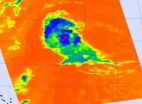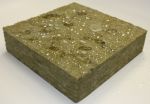(Press-News.org) Fairfax, Va.--The popular spice turmeric packs more than just flavor — it shows promise in fighting devastating viruses, Mason researchers recently discovered.
Curcumin, found in turmeric, stopped the potentially deadly Rift Valley Fever virus from multiplying in infected cells, says Aarthi Narayanan, lead investigator on the new study and a research assistant professor with Mason's National Center for Biodefense and Infectious Diseases.
Mosquito-borne Rift Valley Fever virus (RVF) is an acute, fever-causing virus that affects domestic animals such as cattle, sheep and goats, as well as humans. The research appears this month in the Journal of Biological Chemistry.
"Growing up in India, I was given turmeric all the time," says Narayanan, who has spent the past 18 months working on the project. "Every time my son has a throat infection, I give (turmeric) to him."
There's more work to do before curcumin-based pharmaceuticals become commonplace, Narayanan emphasizes. She plans to test 10 different versions of curcumin to determine which one works the best. She also intends to apply the research to other viruses, including HIV.
Narayanan has long wanted to explore the infection-fighting properties of turmeric, in particular its key component, curcumin. "It is often not taken seriously because it's a spice," she says.
But science is transforming the spice from folk medicine to one that could help a patient's body fight off a virus because it can prevent the virus from taking over healthy cells. These "broad-spectrum inhibitors" work by defeating a wide array of viruses.
"Curcumin is, by its very nature, broad spectrum," Narayanan says. "However, in the published article, we provide evidence that curcumin may interfere with how the virus manipulates the human cell to stop the cell from responding to the infection."
Kylene Kehn-Hall, a co-investigator on the study, adds, "We are very excited about this work, as curcumin not only dramatically inhibits RVFV replication in cell culture but also demonstrates efficacy against RVFV in a mouse model."
Narayanan and her colleagues study the connection between a virus and how it impacts the host — human or animal. Symptoms clue in the researcher about the body's inner workings. Rift Valley Fever and Venezuelan Equine Encephalitis kick off with flu-like symptoms.
Symptoms can make it challenging for someone to recover. The body usually starts with an exaggerated inflammatory response because it doesn't know where to start to rid itself of the virus, she says.
"Many times, the body goes above and beyond what is necessary," Narayanan says. "And that's not good because it's going to influence a bunch of cells around the infection, which haven't seen the bug. That's one way by which disease spreads through your body. And so it is very important to control the host because a lot of times the way the host responds contributes to the disease."
Controlling the symptoms means more than simply making the patients feels better. "You're giving the antiviral a chance to work. Now an antiviral can go in and stop the bug. You're no longer trying to keep the host alive and battling the bug at the same time."
Once Narayanan knows how the body responds to a virus, it's time to go after the bug itself.
She's applying this know-how to a family of viruses called Bunyaviruses, which feature Rift Valley fever, and such alphaviruses as Venezuelan equine encephalitis and retroviruses, which notably include HIV.
She delves into uncovering why and how each virus affects the patient. "Why are some cell types are more susceptible to one type of infection than another?"
HIV goes after the immune system. Bunyaviruses will infect a wide range of cells but do maximum damage to the liver. "What is it about the liver that makes it a sitting duck compared to something like the brain?" Narayanan asks.
Ultimately, curcumin could be part of drug therapies that help defeat these viruses, Narayanan says.
"I know this works. I know it works because I have seen it happen in real life," Narayanan says. "I eat it every day. I make it a point of adding it to vegetables I cook. Every single day."
INFORMATION:
Other Mason researchers involved in the study are Charles Bailey, Ravi Das, Irene Guendel, Lindsay Hall, Fatah Kashanchi, Svetlana Senina and Rachel Van Duyne. Several researchers from other institutions also collaborated.
About George Mason University
George Mason University is an innovative, entrepreneurial institution with global distinction in a range of academic fields. Located in Northern Virginia near Washington, D.C., Mason provides students access to diverse cultural experiences and the most sought-after internships and employers in the country. Mason offers strong undergraduate and graduate degree programs in education, engineering and information technology, organizational psychology, health care and visual and performing arts. With Mason professors conducting groundbreaking research in areas such as climate change, public policy and the biosciences, George Mason University is a leading example of the modern, public university. George Mason University—Where Innovation Is Tradition.
Media contact: Michele McDonald, (703) 993-8781, mmcdon15@gmu.edu
END
Everyone knows the adage: "If something sounds too good to be true, then it probably is." Why, then, do some people fall for scams and why are older folks especially prone to being duped?
An answer, it seems, is because a specific area of the brain has deteriorated or is damaged, according to researchers at the University of Iowa. By examining patients with various forms of brain damage, the researchers report they've pinpointed the precise location in the human brain, called the ventromedial prefrontal cortex, that controls belief and doubt, and which explains why some ...
Ramadan dinners in the Danish Parliament, staff parties without either pork or alcohol and prayer rooms at the airport are all examples of how religion is becoming more visible in public spaces.
"Prior to the mass migration of the '60s, '70s and '80s, almost all Danes shared similar values and were members of the national Christian church, so religion was not an issue in everyday life. There was no need to discuss neither one's own nor another person's religious viewpoint, and secularisation was a matter of course. Today, it is difficult to be in a public place, read ...
VIDEO:
An animation of satellite observations from Aug. 13-16, 2012 shows the birth of the Atlantic Ocean hurricane season's eighth tropical depression that strengthens into Tropical Storm Gordon. This visualization was...
Click here for more information.
NASA has been watching the low pressure system called System 93L for the last week, and late on August 15 it organized into Tropical Depression 8, then Tropical Storm Gordon. NOAA's GOES-13 satellite captured a visible ...
Astronomers using data from NASA's Hubble Space Telescope have caught two clusters full of massive stars that may be in the early stages of merging. The clusters are 170,000 light-years away in the Large Magellanic Cloud, a small satellite galaxy to our Milky Way.
What at first was thought to be only one cluster in the core of the massive star-forming region 30 Doradus (also known as the Tarantula Nebula) has been found to be a composite of two clusters that differ in age by about one million years.
The entire 30 Doradus complex has been an active star-forming region ...
In the quest to understand how the world's weather moves around the globe, scientists have had to tease apart different kinds of atmospheric movement, such as the great jet streams that can move across a whole hemisphere versus more intricate, localized flows. Much the same must currently be done to understand the various motions at work in the great space weather system that links the sun and Earth as the sun shoots material out in all directions, creating its own version of a particle sea to fill up the solar system.
"People think of the sun as giving out light and ...
HOUSTON - A metabolic protein that nourishes cancer cells also activates tumor-promoting genes by loosening part of the packaging that entwines DNA to make up chromosomes, a team led by scientists at The University of Texas MD Anderson Cancer Center reports in the Aug. 16 issue of Cell.
Working in cell lines and mouse models of glioblastoma multiforme, the most lethal form of brain tumor, senior author Zhimin Lu, Ph.D., associate professor of Neuro-Oncology at MD Anderson, and colleagues show that pyruvate kinase M2 (PKM2) fuels tumor growth by influencing a histone protein.
DNA ...
PHILADELPHIA, August 16, 2012 – Without other risk factors, all Americans born between 1945 and 1965 should have a one-time screening for the hepatitis C virus (HCV) according to new recommendations being published early online today in Annals of Internal Medicine, the flagship journal of the American College of Physicians. The Centers for Disease Control and Prevention (CDC) also recommends that all persons identified with HCV should receive a brief alcohol screening and intervention and be referred to appropriate care and treatment services for HCV and related conditions.
Up ...
Thermafiber has officially announced the release of a new continuous insulation product. RainBarrier HD (Heavy Density) is a rigid insulation board with a consistent 6.0pcf density throughout the entire thickness. The consistent density from top to bottom simplifies installation by eliminating the need to orient the insulation in a certain direction like other mixed-density products. The increased density enhances the rigidity and ease of fabrication. The mineral wool board is non-combustible and provides exceptional R-values of 4.2 per inch of thickness. In addition to ...
MINNEAPOLIS – People who are free of dementia and have high levels of a protein that indicates the presence of inflammation have relatives who are more likely to avoid the disease as well, according to a new study published in the August 15, 2012, online issue of Neurology®, the medical journal of the American Academy of Neurology.
"In very elderly people with good cognition, higher levels of C-reactive protein, which is related to inflammation, are associated with better memory," said study author Jeremy M. Silverman, PhD, with Mount Sinai School of Medicine in New ...
An early age at first drink (AFD) has been linked to later alcohol-related problems, which is one of the reasons behind the legal drinking age of 21 in the U.S. It is unclear, however, if increased risk is primarily due to initiation of any drinking, or initiation of heavier drinking. A comparison of the influence of these potential risk factors among college undergraduates found that both an early AFD as well as a quick progression from the first drink to drinking to intoxication independently predicted later problems.
Results will be published in the November 2012 ...




